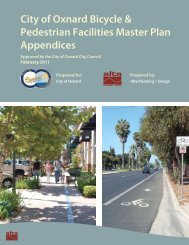View File - Development Services - City of Oxnard
View File - Development Services - City of Oxnard
View File - Development Services - City of Oxnard
You also want an ePaper? Increase the reach of your titles
YUMPU automatically turns print PDFs into web optimized ePapers that Google loves.
WATER RESOURCES TECHNICAL REPORTGroundwater Recovery for Scenario 2c2Location Well Pumpage<strong>City</strong> Water YardBlending Station 3(Rice Ave andGonzales Rd)#20 (LAS)#21 (LAS)#22 (UAS)#23 (UAS)New 1 (UAS)New 2 (UAS)New 3 (UAS)Well 1 (UAS)Well 2 (UAS)Well 3 (UAS)500 AFY (310 gpm)500 AFY (310 gpm)818 AFY (507 gpm)818 AFY (507 gpm)818 AFY (507 gpm)818 AFY (507 gpm)818 AFY (507 gpm)3,394 AFY (2,104 gpm)3,394 AFY (2,104 gpm)3,394 AFY (2,104 gpm)O-H System(All UAS Wells)Additional pumping is apportioned to each <strong>of</strong> the El Riowells according to historic pumping in each <strong>of</strong> those wells.6.1.2 Simulation <strong>of</strong> ScenariosThe Base Case, and the Phase 1 and Phase 2 scenarios, were simulated using the following,consistent with the UWCD update to the groundwater flow model as described below:• The two-layer, updated model grid was used, as shown in Figure 5-2 (regional area) andFigure 5-3 (local area).• The period <strong>of</strong> simulation was 31 years, from 2001 through 2031, with four time-stepswithin each year representing winter, spring, summer, and fall quarters (quarters 1, 2, 3,and 4, respectively, <strong>of</strong> each year). Recharge by direct injection is assumed to occur inquarter 1 (when pumping demands are lower) and in-lieu recharge is assumed to occurin quarters 2, 3, and 4 (when pumping demands are higher).• The model hydrology was assigned to three types <strong>of</strong> years: wet, normal, and dry, whichare defined by flow in the Santa Clara River. Dry years are defined as flow less than52,000 AFY; normal years are defined as flow between 52,000 and 200,000 AFY; and wetyears are defined as flow greater than 2000 AFY.• The hydrology and precipitation for the 31-year simulation period was generated byrepeating the precipitation and hydrology from 1970 through 2000.The cumulative departure from average precipitation for the model simulations is shown inFigure 6-1. The cumulative departure curve is generated by adding 1970 through 2000precipitation to the historical precipitation from 1890 through 2000. The model precipitation,model cumulative departure from average, and hydrology year types for each <strong>of</strong> the modelyears are shown in Figure 6-1. The hydrology from 1970 through 2000 resulted in 7 dryyears, 13 normal years, and 11 wet years over the 31-year simulation period.W112003002SCO LW1458.DOC/ 033390002 80
















